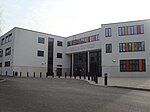St Wilfrid's Catholic School
1953 establishments in EnglandBuildings and structures in CrawleyCatholic secondary schools in the Diocese of Arundel and BrightonEducational institutions established in 1953Secondary Schools in Crawley ... and 3 more
Secondary schools in West SussexUse British English from February 2023Voluntary aided schools in England
St Wilfrid's Catholic School is a voluntary aided comprehensive Catholic secondary school in Crawley, West Sussex, England for pupils aged 11 to 18. It caters for 936 pupils in years 7 to 13, including 181 in its sixth form.
Excerpt from the Wikipedia article St Wilfrid's Catholic School (License: CC BY-SA 3.0, Authors).St Wilfrid's Catholic School
St. Augustine Road,
Geographical coordinates (GPS) Address External links Nearby Places Show on map
Geographical coordinates (GPS)
| Latitude | Longitude |
|---|---|
| N 51.1097 ° | E -0.2031 ° |
Address
St Wilfrid's Catholic School
St. Augustine Road
RH11 8PG
England, United Kingdom
Open on Google Maps








